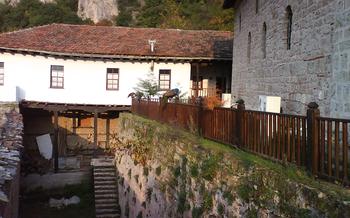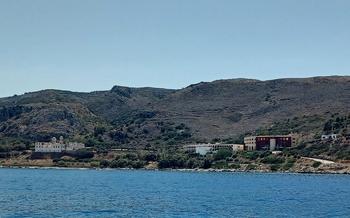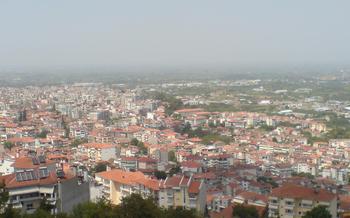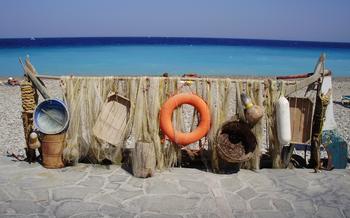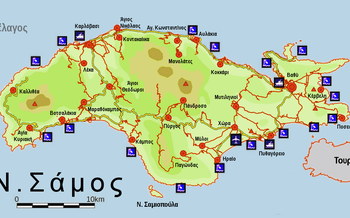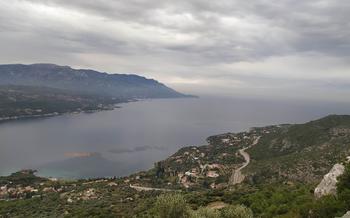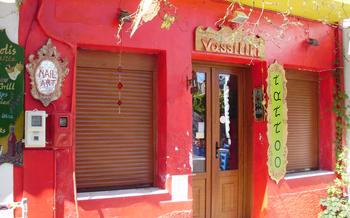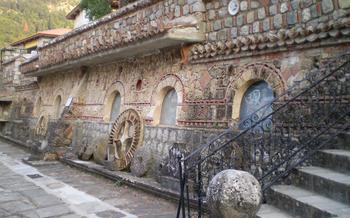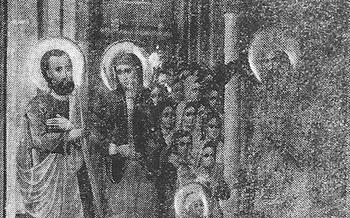
The Monastery of Saint John the Theologian
- History and Significance:
- Breathtaking Frescoes
- Serene Ambiance
- Monastic Life
- Pilgrimage Destination
- Panoramic Views:
- Souvenirs and Handicrafts
- Photography Opportunities:
- Accessibility
- Guided Tours:
- Respectful Attire
- Local Festivals
- Insider Tip:
History and Significance:
Nestled in the picturesque Veria valley, the Monastery of Saint John the Theologian stands as a testament to faith, resilience, and architectural brilliance. Built in the 11th century, the monastery is dedicated to Saint John the Theologian, one of the twelve apostles of Jesus Christ. Saint John, also known as John the Evangelist, holds a prominent position in Christianity, authoring the Gospel of John and the Book of Revelation. The monastery serves as a significant pilgrimage site for Orthodox Christians, who seek spiritual solace and pay homage to the saint.
Breathtaking Frescoes
The Monastery of Saint John the Theologian is renowned for its exquisite Byzantine frescoes, which adorn the walls and ceilings of the church and other buildings within the complex. Created by skilled artists over several centuries, these frescoes depict biblical scenes, saints, and theological concepts with remarkable detail and artistry.
The frescoes employ a vibrant palette of colors, with gold leaf accents that shimmer in the light, creating a sense of awe and wonder. The scenes depicted include moments from the life of Christ, such as his birth, crucifixion, and resurrection, as well as images of the Virgin Mary, the apostles, and various saints.
Beyond their artistic beauty, the frescoes also hold deep religious and symbolic meaning. They serve as a visual representation of the Orthodox faith, teaching and illustrating important theological concepts and stories from the Bible. The intricate details and symbolism in the frescoes invite visitors to contemplate and reflect on the spiritual significance of the monastery and the teachings of Saint John the Theologian.
Serene Ambiance
Nestled amidst the picturesque landscapes of Veria, the Monastery of Saint John the Theologian exudes an atmosphere of tranquility that invites visitors to immerse themselves in spiritual reflection and prayer. The serene surroundings of the monastery provide a sanctuary for those seeking solace and connection with their inner selves. The air is filled with the melodious sounds of birdsong, while the gentle breeze rustles through the leaves of ancient trees, creating a symphony of nature that enhances the tranquility of the environment. As you step foot within the monastery's walls, a sense of peace washes over you, enveloping you in a comforting embrace. The serene ambiance encourages contemplation and introspection, allowing visitors to shed their worldly concerns and find spiritual renewal.
The monastery's architecture is designed to complement its serene surroundings. The simple yet elegant lines of the buildings harmonize with the natural beauty of the landscape, creating a cohesive environment that promotes inner peace. Whether you choose to wander through the tranquil gardens, marvel at the intricate frescoes that adorn the walls, or simply sit in silence and meditate, the monastery offers countless opportunities for spiritual growth and self-discovery. As you bask in the serenity of this sacred space, you may find yourself drawn to a deeper connection with your spiritual side, leaving the monastery with a renewed sense of purpose and tranquility.
Monastic Life
Within the walls of the monastery, a community of dedicated monks leads a life of devotion and service. Their daily routine revolves around prayer, meditation, and the fulfillment of their monastic duties. Visitors are often struck by the serene atmosphere that permeates the monastery, a testament to the monks' spiritual dedication.
Early morning prayers mark the beginning of the day, followed by individual contemplation and study. The monks gather in the monastery's chapel for communal prayers and services throughout the day. In addition to their religious observances, the monks engage in various tasks to sustain the monastery and contribute to the local community. They may tend to gardens, perform restoration work, or offer guidance to pilgrims and visitors.
The monastery's role in preserving religious traditions is of paramount importance. The monks are custodians of ancient manuscripts, icons, and other sacred artifacts. They diligently maintain the monastery's library, which houses a wealth of historical and theological texts. Through their dedication to preserving these traditions, the monks ensure that the monastery remains a vibrant center of Orthodox Christianity.
Pilgrimage Destination
The Monastery of Saint John the Theologian holds immense significance as a pilgrimage site for Orthodox Christians. Its reputation as a spiritual haven attracts devout believers from far and wide, seeking solace, blessings, and a profound connection with their faith. Throughout the year, the monastery welcomes numerous pilgrims who embark on a journey of religious devotion and spiritual renewal.
One of the highlights for pilgrims is the opportunity to venerate the relics of Saint John the Theologian, which are enshrined within the monastery's sacred precincts. Believers flock to pay homage to this revered saint, seeking his intercession and blessings. The monastery also hosts several religious festivals and events throughout the year, attracting large gatherings of pilgrims and worshippers. These festivals showcase the rich traditions and customs of the Orthodox Church, providing a vibrant and immersive experience for all participants.
Panoramic Views:
The Monastery of Saint John the Theologian offers breathtaking panoramic views of the surrounding Veria valley, adding to its allure as a must-visit destination. Perched atop a hill, the monastery provides visitors with an unparalleled opportunity to witness the beauty of the natural landscape. As you gaze out from the monastery's vantage point, you'll be mesmerized by the rolling hills, lush greenery, and distant mountains that paint a picturesque backdrop. The monastery's elevated position allows for unobstructed views, making it an ideal spot to capture stunning photographs. Whether you're a nature enthusiast, a photography buff, or simply seeking a moment of tranquility, the panoramic vistas from the Monastery of Saint John the Theologian will leave you in awe.
Insider Tip:
For the most awe-inspiring views, visit the monastery during sunset. As the golden hues of the setting sun bathe the landscape in a warm glow, the valley transforms into a breathtaking spectacle. Capture the magical moment with your camera or simply soak in the serene beauty of the surroundings.
Souvenirs and Handicrafts
As you explore the monastery, take the opportunity to visit the small gift shop, where you can purchase unique souvenirs and handicrafts made by the monks themselves. These items are not only beautiful but also serve as a tangible reminder of your visit to this sacred place. From intricately carved wooden crosses to delicate hand-painted icons, each piece is a work of art that reflects the monastery's rich spiritual heritage. By making a purchase, you not only support the monastery's community but also contribute to the preservation of traditional Greek craftsmanship.
Photography Opportunities:
The Monastery of Saint John the Theologian offers a wealth of photogenic scenes, making it a paradise for photography enthusiasts. The picturesque architecture, intricate frescoes, and serene surroundings create a captivating backdrop for capturing stunning images.
As you explore the monastery grounds, keep an eye out for the following photo-worthy spots:
-
The grand entrance: The imposing entrance gate, with its arched doorway and intricate carvings, is a sight to behold. Capture the symmetry and grandeur of this architectural masterpiece.
-
The stunning frescoes: The monastery's walls are adorned with exquisite Byzantine frescoes that depict biblical scenes and saints. Take your time to admire the vibrant colors, intricate details, and expressive faces of these sacred works of art.
-
The panoramic views: From the monastery's vantage point, you can enjoy breathtaking views of the surrounding Veria valley. Capture the rolling hills, lush greenery, and distant mountains in a single frame.
-
The idyllic courtyard: The monastery's courtyard, with its blooming flowers, tranquil fountains, and elegant arches, offers a serene and picturesque setting. Capture the play of light and shadow as the sun filters through the trees, creating a magical atmosphere.
-
The hidden corners: Explore the monastery's hidden nooks and crannies to discover secret spots that offer unique perspectives and compositions. Capture the charm of these secluded corners, where time seems to stand still.
Remember to be respectful of the sacred nature of the monastery when taking photographs. Avoid using flash photography near the frescoes and be mindful of the monks' privacy.
Accessibility
The Monastery of Saint John the Theologian is easily accessible by car or public transportation. For those traveling by car, there is a spacious parking area available near the monastery. Alternatively, several bus lines stop nearby, making it convenient for visitors to reach the site using public transport.
To ensure a seamless visit, it is advisable to check the bus schedules in advance and plan your journey accordingly. The monastery is well-equipped to accommodate visitors with limited mobility. Wheelchair-accessible ramps and designated parking spaces are available, allowing everyone to experience the monastery's beauty and serenity.
Guided Tours:
Enhance your visit to the Monastery of Saint John the Theologian by joining a guided tour. Led by knowledgeable guides, these tours offer a deeper understanding of the monastery's rich history, architecture, and religious significance. Available in various languages, the tours provide insights into the lives of the monks, the symbolism behind the frescoes, and the role of the monastery in preserving Orthodox traditions. Embark on a journey of discovery, allowing the monastery's stories to come to life as you explore its sacred spaces.
Respectful Attire
As a sacred site, the Monastery of Saint John the Theologian requires visitors to adhere to a modest dress code. When entering the monastery, it is essential to show respect for the religious traditions and atmosphere by dressing appropriately. For men, it is customary to wear long pants or shorts that cover the knees, and a shirt with sleeves. Women are expected to wear skirts or dresses that fall below the knee, and tops that cover the shoulders. Avoid wearing revealing or beachwear, as this may be considered disrespectful. By observing the dress code, you contribute to maintaining the sanctity of the monastery and show consideration for the monks and other visitors.
Local Festivals
Immerse yourself in the vibrant local culture by participating in festivals and events held near the Monastery of Saint John the Theologian. These celebrations offer a unique opportunity to experience the rich traditions and customs of Veria and its surrounding region. Join the locals in their joyous festivities, indulge in delicious local cuisine, and witness traditional dances and music performances. Embrace the warmth and hospitality of the Greek people as you become part of these vibrant celebrations.
Insider Tip:
Amidst the bustling monastery grounds, there lies a hidden gem waiting to be discovered. Tucked away from the main paths, a secluded garden beckons visitors seeking a moment of tranquility. Surrounded by fragrant flowers, ancient olive trees, and the gentle sound of a nearby fountain, this serene spot invites you to pause and reflect. As the sun casts its golden rays through the tree canopy, creating a magical ambiance, you can sit on a weathered bench and let your thoughts wander. Indulge in the peacefulness of this sacred space, where time seems to stand still and the only sound is the gentle rustle of leaves in the breeze. Whether you're seeking inspiration, solace, or simply a moment of respite, this hidden garden offers a sanctuary for the soul.
